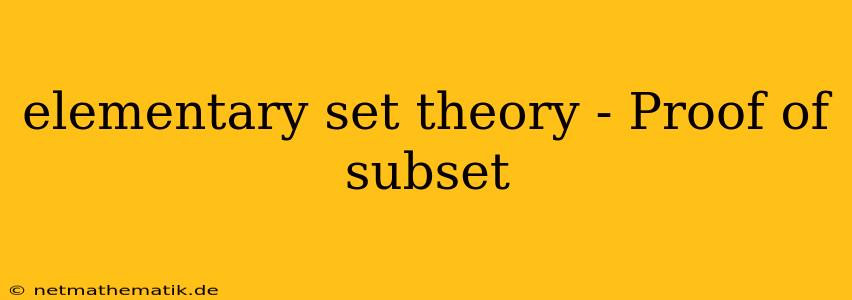Delving into the Essence of Subsets: A Comprehensive Proof
In the realm of mathematics, understanding the concept of subsets is fundamental, especially in the field of set theory. A subset, in essence, is a collection of elements that are all contained within a larger collection. While this concept seems intuitive, rigorously proving the inclusion of one set within another requires a formal approach. This article aims to explore the intricacies of proving a subset, delving into the fundamental principles of elementary set theory and providing a comprehensive understanding of the underlying logic.
Defining the Foundations: Set Theory Basics
Before we embark on the journey of proving subsets, it is essential to establish a solid understanding of the basic terminology and axioms that underpin set theory.
Sets and Elements
At its core, set theory deals with collections of objects, called sets. These objects, or elements, are the building blocks of any set. For instance, the set of all even numbers can be represented as {2, 4, 6, 8...} where each individual number (2, 4, 6, etc.) is an element of the set.
The Concept of Subsets
The core concept we are exploring is the subset. A subset is a set whose elements are all contained within another set. This relationship is denoted by the symbol ⊆.
Example:
Consider the set A = {1, 2, 3} and the set B = {1, 2, 3, 4, 5}. We can observe that all the elements of set A (1, 2, 3) are also present in set B. Therefore, we can say that set A is a subset of set B, denoted as A ⊆ B.
Formal Definition of a Subset
More formally, a set A is a subset of a set B if and only if every element of A is also an element of B. This can be expressed as:
- For every element x in A, x is also in B.
Proving a Subset: The Methodological Approach
Proving that one set is a subset of another requires demonstrating that every element in the smaller set is also present in the larger set. This can be accomplished through a methodical approach:
1. Assumption:
Begin by assuming that we have an arbitrary element x that belongs to set A (x ∈ A). This assumption is crucial as it allows us to work with a generic element, ensuring that our proof holds for every element in A.
2. Deduction:
Next, we need to demonstrate that this assumed element x also belongs to set B (x ∈ B). This can be achieved by using the specific properties of the sets A and B, the definition of the elements in each set, or any applicable theorems from set theory.
3. Conclusion:
Once we have successfully deduced that x ∈ B based on our assumption of x ∈ A, we can conclude that every element of A is also an element of B. This validates the statement A ⊆ B.
Illustrative Examples of Proofs
To solidify our understanding, let's delve into concrete examples of proving subsets:
Example 1:
-
Claim: The set of all even numbers is a subset of the set of all integers.
-
Proof:
-
Assumption: Let x be an arbitrary even number, meaning x ∈ {2, 4, 6, 8...}.
-
Deduction: By the definition of even numbers, x can be expressed as 2n, where n is an integer. Since 2n is also an integer, x ∈ {..., -3, -2, -1, 0, 1, 2, 3...}.
-
Conclusion: Therefore, every even number is also an integer. Hence, the set of all even numbers is a subset of the set of all integers.
-
Example 2:
-
Claim: The set of all natural numbers is a subset of the set of all real numbers.
-
Proof:
-
Assumption: Let x be an arbitrary natural number, meaning x ∈ {1, 2, 3, 4...}.
-
Deduction: Every natural number can be represented as a real number. Since the natural numbers are a subset of the real numbers, x ∈ {..., -2, -1, 0, 1, 2, 3...}.
-
Conclusion: Therefore, every natural number is also a real number. Hence, the set of all natural numbers is a subset of the set of all real numbers.
-
Key Considerations and Implications
Proving subsets is a fundamental skill in set theory and has wide-ranging implications across various branches of mathematics.
Important Notes:
- The Empty Set: The empty set {} is considered a subset of every set, including itself. This is because there are no elements in the empty set that do not belong to any other set.
- Proper Subsets: A proper subset is a subset that does not include all the elements of the original set. It is denoted by ⊂. For instance, {1, 2} is a proper subset of {1, 2, 3} because it does not include the element 3.
- Power Set: The power set of a set is the set of all possible subsets. For example, the power set of {1, 2} is {{}, {1}, {2}, {1, 2}}.
Conclusion
Understanding and proving subsets is crucial for developing a solid foundation in elementary set theory. This process involves demonstrating that every element in the smaller set is also present in the larger set, requiring a methodical approach based on the principles of set theory. By mastering the ability to prove subsets, we gain the ability to analyze relationships between sets, identify their properties, and ultimately, contribute to a deeper understanding of the intricate world of mathematics.
